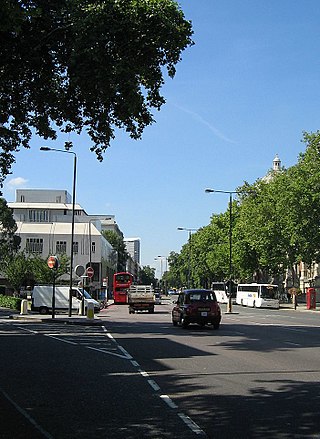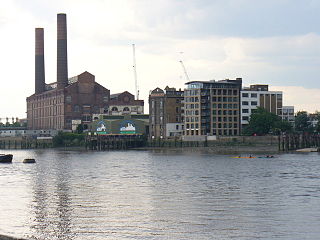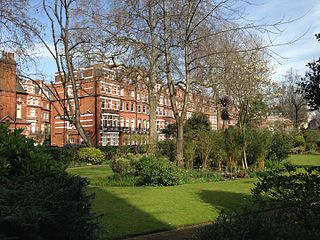
The Royal Borough of Kensington and Chelsea is an Inner London borough with royal status. It is the smallest borough in London and the second smallest district in England; it is one of the most densely populated administrative regions in the United Kingdom. It includes affluent areas such as Notting Hill, Kensington, South Kensington, Chelsea, and Knightsbridge.

Earl's Court is a district of Kensington in the Royal Borough of Kensington and Chelsea in West London, bordering the rail tracks of the West London line and District line that separate it from the ancient borough of Fulham to the west, the sub-districts of South Kensington to the east, Chelsea to the south and Kensington to the northeast. It lent its name to the now defunct eponymous pleasure grounds opened in 1887 followed by the pre–World War II Earls Court Exhibition Centre, as one of the country's largest indoor arenas and a popular concert venue, until its closure in 2014.

Cromwell Road is a major London road in the Royal Borough of Kensington and Chelsea, designated as part of the A4. It was created in the 19th century and is said to be named after Richard Cromwell, son of Oliver Cromwell, who once owned a house there.

South Kensington is a district just west of Central London in the Royal Borough of Kensington and Chelsea. Historically it settled on part of the scattered Middlesex village of Brompton. Its name was supplanted with the advent of the railways in the late 19th century and the opening and naming of local tube stations. The area has many museums and cultural landmarks with a high number of visitors, such as the Natural History Museum, the Science Museum and the Victoria and Albert Museum. Adjacent affluent centres such as Knightsbridge, Chelsea and Kensington, have been considered as some of the most exclusive real estate in the world.

Counter's Creek, ending in Chelsea Creek, the lowest part of which still exists, was a stream that flowed from Kensal Green, by North Kensington and flowed south into the River Thames on the Tideway at Sands End, Fulham. Its remaining open watercourse is the quay of Chelsea Creek.

Brompton Road is a street located in the southern part from Knightsbridge and in the eastern part from Brompton in the Royal Borough of Kensington and Chelsea and partly the City of Westminster in London.

Gloucester Road is a street in the Royal Borough of Kensington and Chelsea, London. It runs north–south between Kensington Gardens and Old Brompton Road.

West Kensington, formerly North End, is an area in the ancient parish of Fulham, in the London Borough of Hammersmith and Fulham, England, 3.4 miles (5.5 km) west of Charing Cross. It covers most of the London postal area of W14, including the area around Barons Court tube station, and is defined as the area between Lillie Road and Hammersmith Road to the west, Fulham Palace Road to the south, Hammersmith to the north and West Brompton and Earl's Court to the east. The area is bisected by the major London artery the A4, locally known as the Talgarth Road. Its main local thoroughfare is the North End Road.

Fulham Road is a street in London, England, which comprises the A304 and part of the A308.

Brompton, sometimes called Old Brompton, survives in name as a ward in the Royal Borough of Kensington and Chelsea in London. Until the latter half of the 19th century it was a scattered village made up mostly of market gardens in the county of Middlesex. It lay southeast of the village of Kensington, abutting the parish of St Margaret's, Westminster at the hamlet of Knightsbridge to the northeast, with Little Chelsea to the south. It was bisected by the Fulham Turnpike, the main road westward out of London to the ancient parish of Fulham and on to Putney and Surrey. It saw its first parish church, Holy Trinity Brompton, only in 1829. Today the village has been comprehensively eclipsed by segmentation due principally to railway development culminating in London Underground lines, and its imposition of station names, including Knightsbridge, South Kensington and Gloucester Road as the names of stops during accelerated urbanisation, but lacking any cogent reference to local history and usage or distinctions from neighbouring settlements.

West Brompton is an area of west London, England, that straddles the boundary between the London Borough of Hammersmith and Fulham and Royal Borough of Kensington and Chelsea. The centuries-old boundary traced by Counter's Creek, probably marked the eastern edge of Fulham Manor since Saxon times and is now partly lost beneath the West London Line railway.

The Coleherne Arms 1866 public house was a gay pub in west London. Located at 261 Old Brompton Road, Earl's Court, it was a well-known music venue from the 1950s, and a popular landmark leather bar during the 1970s and 1980s. In 2008, it was rebranded as a gastropub, The Pembroke.

The Boltons is a street and garden square of lens shape in the Brompton district of the Royal Borough of Kensington and Chelsea, London, England. The opposing sides of the street face the communal gardens with large expansive houses and gardens, in what is considered the second most expensive street in the country with an average house price of £23.1m. The elliptical central gardens of the Boltons are Grade II listed on the Register of Historic Parks and Gardens.

Redcliffe Square, nestled in the prestigious Boltons Conservation Area of Chelsea, is a peaceful and scenic town square known for its rich historical character and lush, meticulously maintained gardens and its Victorian and Second Empire-style mansion blocks. It is located in the Brompton area of the Royal Borough of Kensington and Chelsea, southwest of central London,. Redcliffe Square Gardens are located in the square. The development was part of the vast Gunter estate, during 1864–1878.

Pembroke Square is located in the Kensington area of southwest central London, England. The whole square is Grade II listed for its architectural merit. It was developed by the Hawks family.

Onslow Square is a garden square in South Kensington, London, England.

Lillie Road is a major street in the north of Fulham, in the London Borough of Hammersmith and Fulham. Named for the Peninsular War veteran, John Scott Lillie, it is a mixed residential and commercial thoroughfare, and is the westerly continuation of the Old Brompton Road, the A3218 road, running from Lillie Bridge to the A219 Fulham Palace Road. Its main junctions are with North End Road and with Munster Road at Fulham Cross.

Egerton Gardens is a street and communal garden, regionally termed a garden square, in South Kensington, London SW3.

Warwick Road is located in the Earl's Court district of the Royal Borough of Kensington & Chelsea in London. The road began to be laid out around 1822 and was gradually extended south to Old Brompton Road over a number of decades. It is a major north–south traffic route in west London.

Coleherne Court is a large apartment block on the Old Brompton Road in the Earl's Court district of the Royal Borough of Kensington and Chelsea.





















